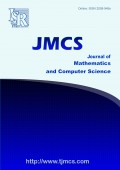Analysis of the dynamics of a mathematical model for HIV infection
Volume 23, Issue 3, pp 181--195
http://dx.doi.org/10.22436/jmcs.023.03.02
Publication Date: November 01, 2020
Submission Date: July 18, 2020
Revision Date: September 15, 2020
Accteptance Date: September 17, 2020
-
1163
Downloads
-
2387
Views
Authors
Bhagya Jyoti Nath
- Department of Mathematics, Barnagar College, Sorbhog, 781317, Barpeta, Assam, India.
Kaushik Dehingia
- Department of Mathematics, Gauhati University, Guwahati, 781014, Assam, India.
Hemanta Kumar Sarmah
- Department of Mathematics, Gauhati University, Guwahati, 781014, Assam, India.
Abstract
Mathematical models are essential tools in the study of different infectious diseases. Researchers have developed other in-host models to investigate HIV dynamics in the human body. In this paper, a mathematical model for the HIV infection of \(CD4^+\) T cells is analyzed. We consider the proliferation of T cells in this study. It is found that there exist two equilibrium states for this model: Infection-free equilibrium state and infected equilibrium state. Local stability is discussed for both infection-free and infected equilibrium states using Routh--Hurwitz criteria. Also, we calculate the basic reproduction number \((R_0)\) for the model with the help of next generation matrix method. The global stability of the infection-free equilibrium point is discussed using Lyapunov's second method. From the stability analysis, it is found that if basic reproduction number \(R_0 \leq 1\), infection of HIV is cleared out, and if \(R_0 >1\), infection of HIV persists. The conditions for global stability of the infected equilibrium point are derived using a geometric approach. We find a parameter region where the infected equilibrium point is globally stable. We carry out numerical simulations to verify the results. Also, the effects of the proliferation rate of uninfected \(CD4^+\) T cells and recovery rate of infected \(CD4^+\) T cells in dynamics of the T cells and free virus are studied using numerical simulations. It is found that small variations of these parameters can change the model's whole dynamics, and infection can be controlled by controlling the proliferation rate and improving the recovery rate.
Share and Cite
ISRP Style
Bhagya Jyoti Nath, Kaushik Dehingia, Hemanta Kumar Sarmah, Analysis of the dynamics of a mathematical model for HIV infection, Journal of Mathematics and Computer Science, 23 (2021), no. 3, 181--195
AMA Style
Nath Bhagya Jyoti, Dehingia Kaushik, Sarmah Hemanta Kumar, Analysis of the dynamics of a mathematical model for HIV infection. J Math Comput SCI-JM. (2021); 23(3):181--195
Chicago/Turabian Style
Nath, Bhagya Jyoti, Dehingia, Kaushik, Sarmah, Hemanta Kumar. "Analysis of the dynamics of a mathematical model for HIV infection." Journal of Mathematics and Computer Science, 23, no. 3 (2021): 181--195
Keywords
- HIV infection
- global stability
- \(CD4^+\) T cells
- basic reproduction number
MSC
References
-
[1]
J. Alvarez-Ramirez, M. Meraz, J. X. Velasco-Hernandez, Feedback control of the chemotherapy of HIV, Int. J. Bifur. Chaos, 10 (2000), 2207--2219
-
[2]
P. Chandra, Mathematical modeling of HIV dynamics: In vivo, Math. Student, 78 (2009), 7--27
-
[3]
W. A. Copppel, Stability and Asymptotic Behaviour of Differential Equations, Health, Boston (1965)
-
[4]
P. V. Driessche, J. Watmough, Reproduction numbers and sub-threshold endemic equilibra for compartmental models of disease transmission, Math. Biosci., 180 (2002), 29--48
-
[5]
P. Essunger, A. S. Perelson, Modelling HIV infection $CD4^+$ T-cell subpopulations, J. Theor. Biol., 170 (1994), 367--391
-
[6]
T. Gao, W. Wang, X. Liu, Mathematical analysis of an HIV model with impulsive antiretroviral drug doses, Math. Comput. Simulation, 82 (2011), 653--665
-
[7]
J. P. LaSalle, The Stability of Dynamical Systems,in: Regional Conference Series in Applied Mathematics, SIAM, Philadelaphia (1976)
-
[8]
M. Y. Li, J. S. Muldowney, A geometric approach to the global-stability problems, SIAM J. Math. Anal., 27 (1996), 1070--1083
-
[9]
R. H. Martin, Logarithimic norms and projections applied to linear differenetial systems, J. Math. Anal. Appl., 45 (1974), 432--454
-
[10]
M. A. Nowak, S. Bonhoeffer, G. M. Shaw, R. M. May, Antiviral drug treatment: dynamics of resistance in free virus and infected cell populations, J. Theor. Biol., 184 (1997), 203--217
-
[11]
M. A. Nowak, R. M. May, Virus dynamics: mathematical principles of immunology and virology: mathematical principles of immunology and virology, Oxford University Press, Oxford (2000)
-
[12]
A. S. Perelson, D. E. Kirschner, R. J. De Boer, Dynamics of HIV infection of CD4+ T cells, Math. Biosci., 114 (1993), 81--125
-
[13]
A. S. Perelson, P. W. Nelson, Mathematical Analysis of HIV-1 Dynamics in Vivo, SIAM Rev., 41 (1999), 3--44
-
[14]
L. Rong, M. A. Gilchrist, Z. Feng, A. S. Perelson, Modeling within host HIV-1 dynamics and the evolution of drug resistance: Trade-offs between viral enzyme function and drug susceptibility, J. Theor. Biol., 247 (2007), 804--818
-
[15]
H. L. Smith, P. D. Leenheer, Virus dynamics: a global analysis, SIAM J. Appl. Math., 63 (2003), 1313--1327
-
[16]
X. Song, A. U. Neumann, Global stability and periodic solution of the viral dynamics, J. Math. Anal. Appl., 329 (2007), 281--297
-
[17]
P. K. Srivastava, M. Banerjee, P. Chandra, Dynamical Model of in-host HIV infection: With Drug therapy and Multi viral strains, J. Biol. Syst., 20 (2012), 303--325
-
[18]
P. K. Srivastava, P. Chandra, Modeling the dynamics of HIV and $CD4^+$ T cells during primary infection, Nonlinear Anal. Real World Appl., 11 (2010), 612--618
-
[19]
, World Health Organisation HIV/AIDS Key facts, WHO, ()

